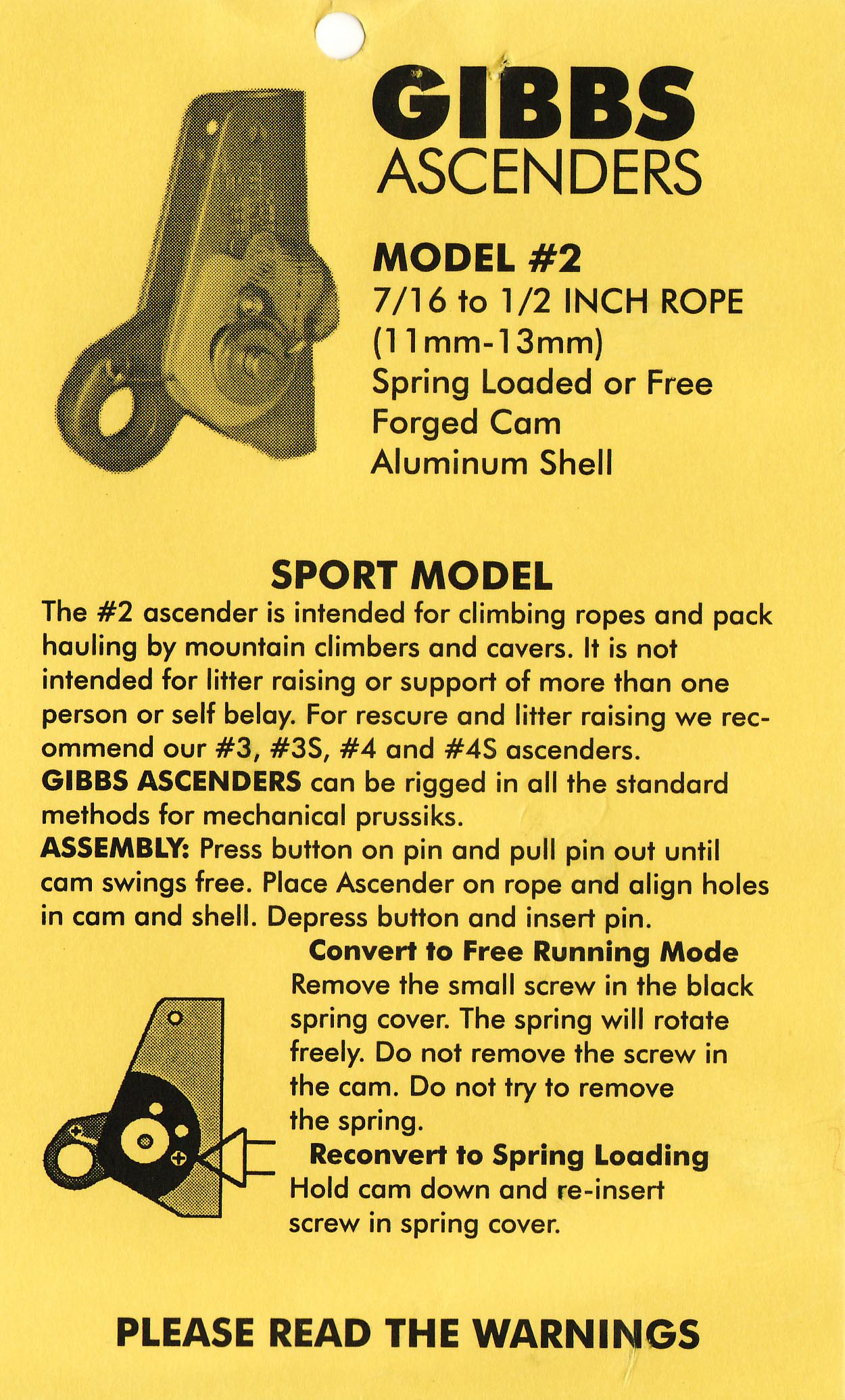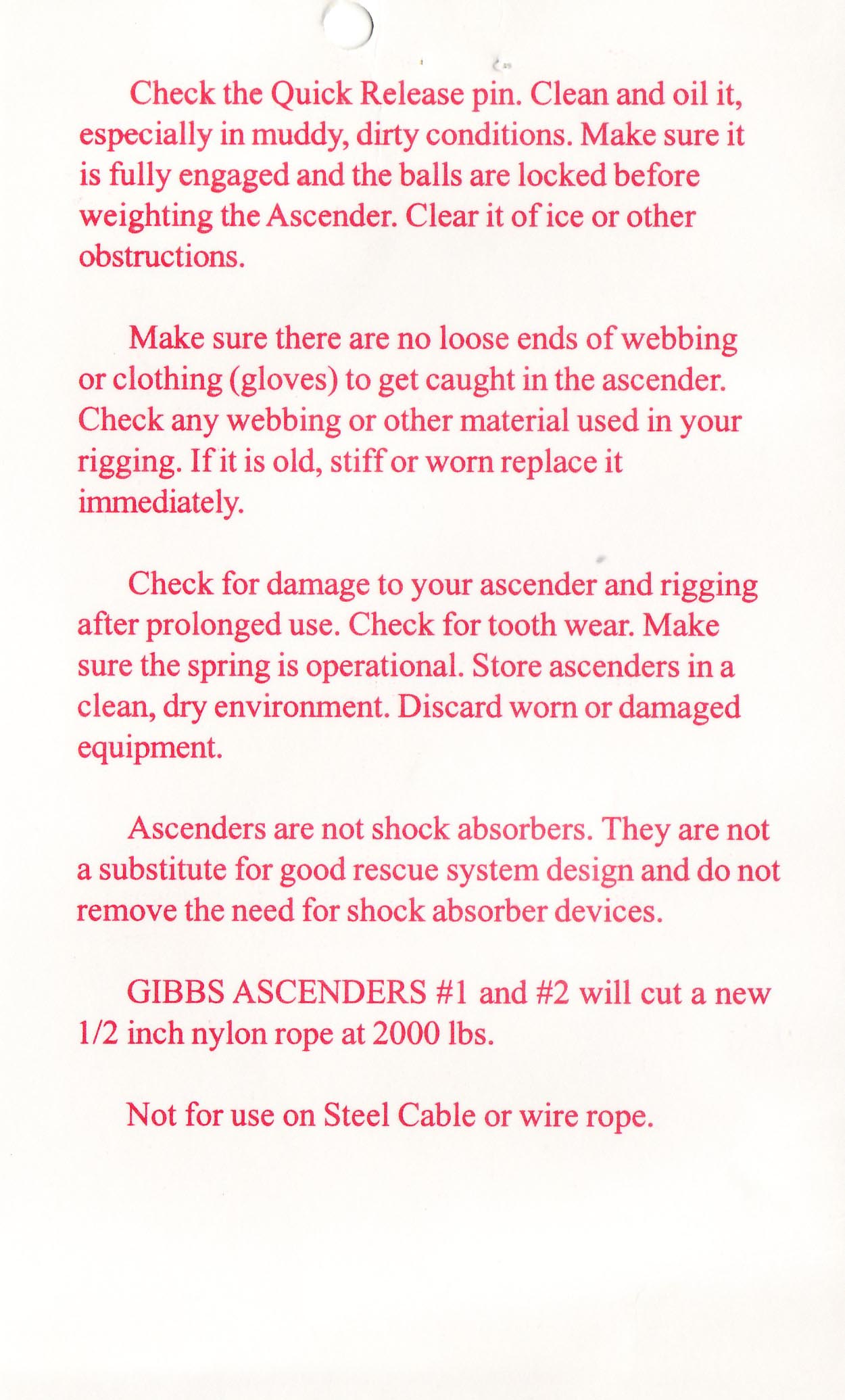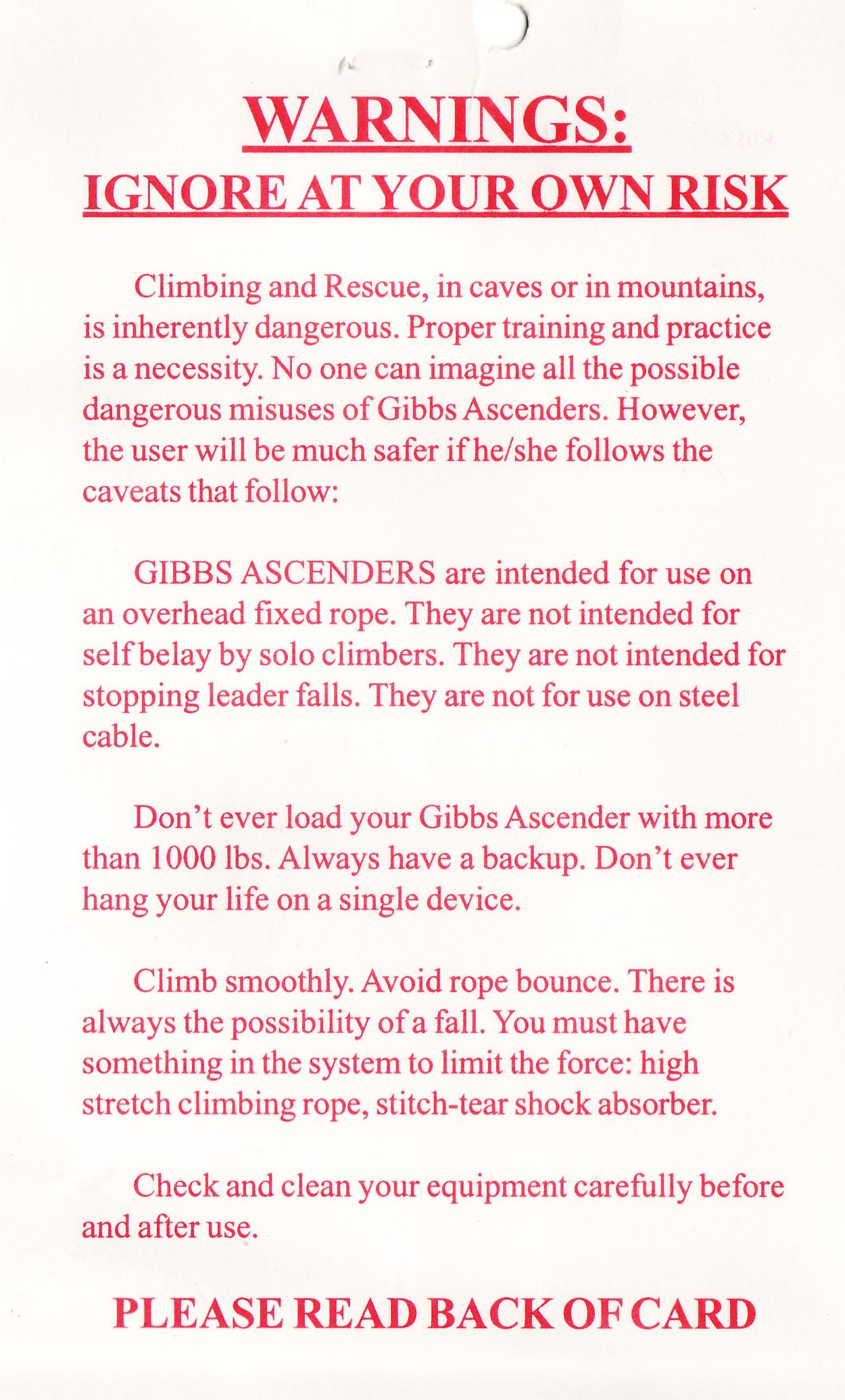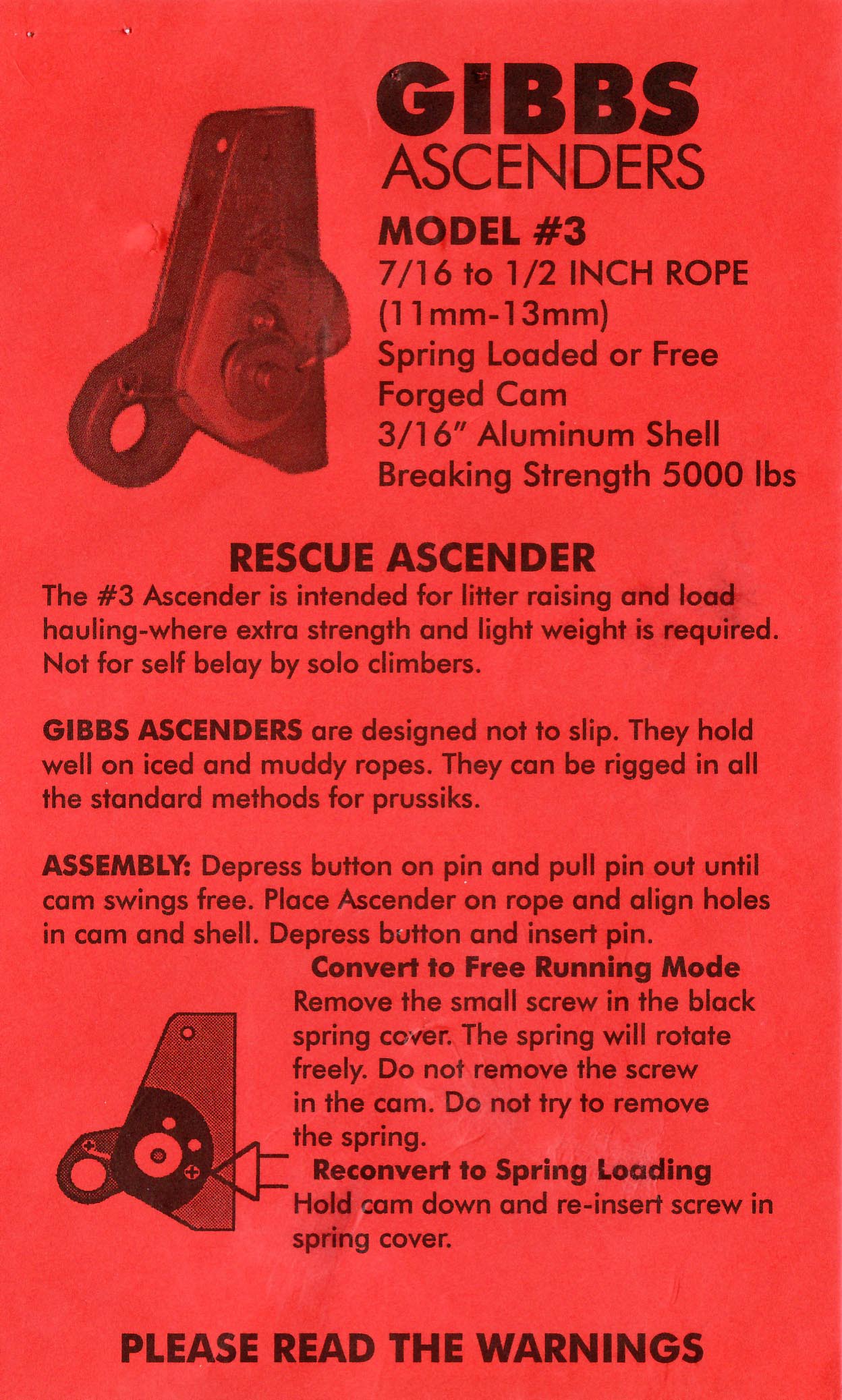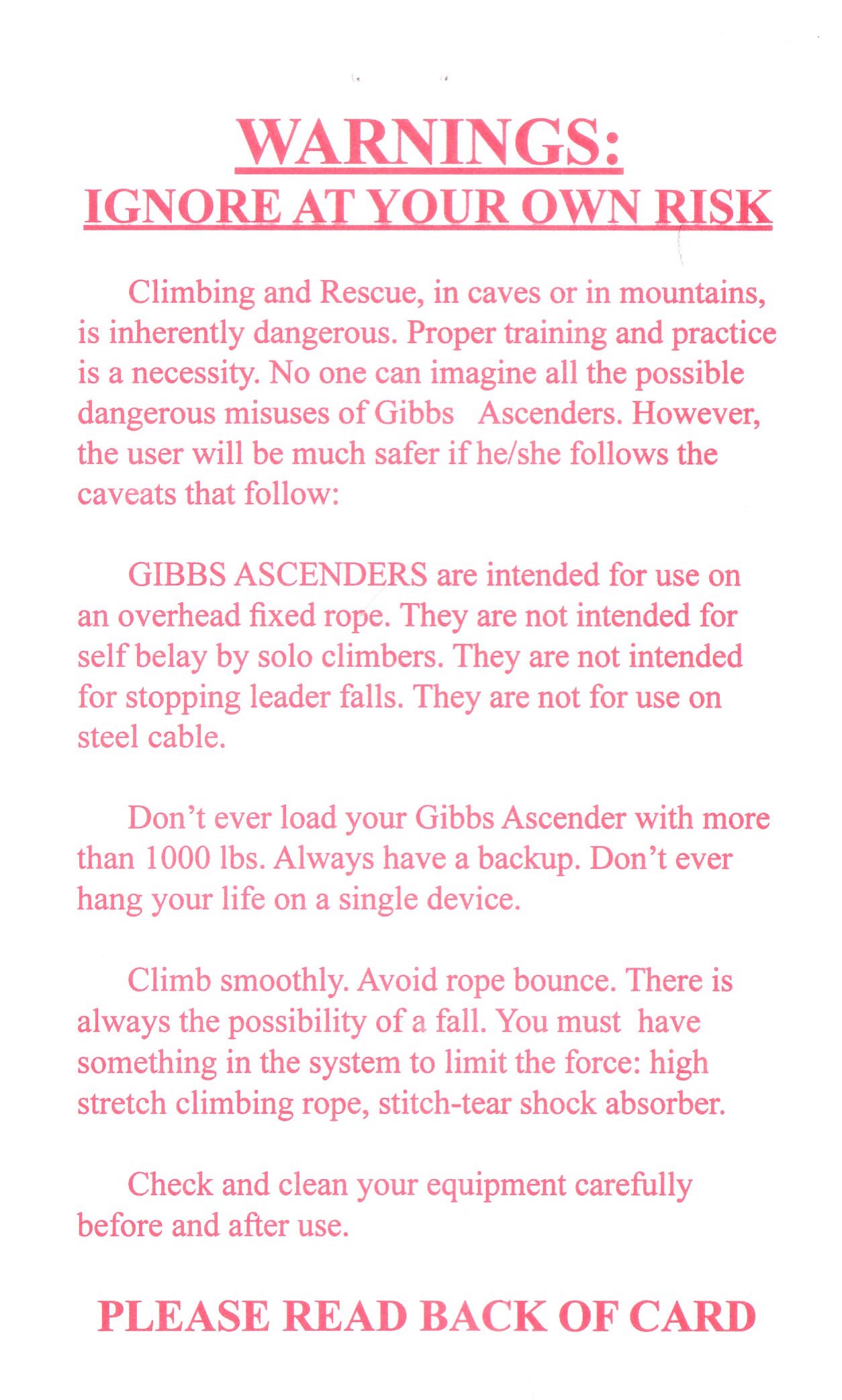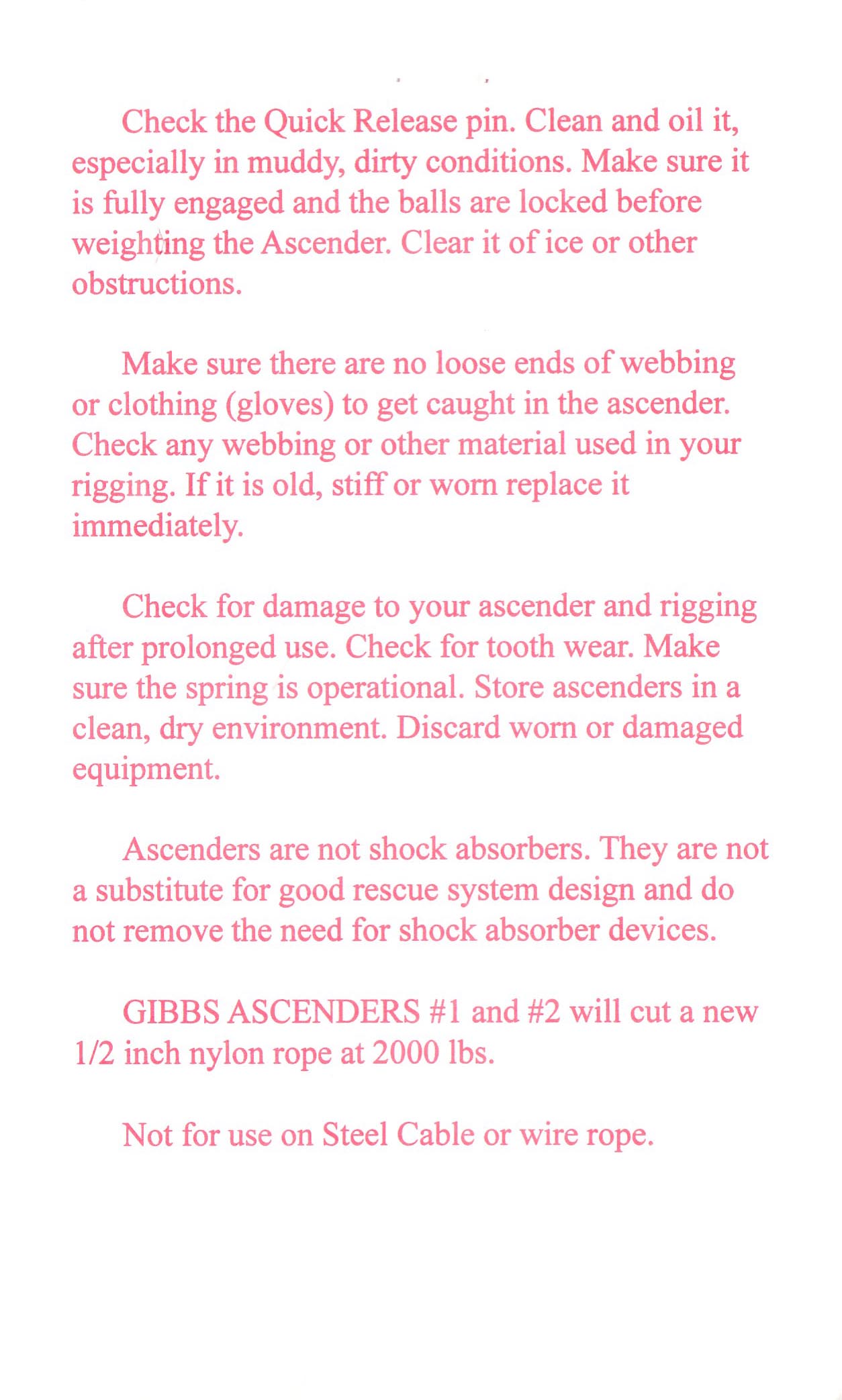Overview
[ Top
| #2 v. A
| #2 v. B
| #2SS, v. A
| #2SS, v. B
| #2SS, v. C
| #2SS, v. D
| #2SS, v. E
| #3 v. B
| #3S, v. A
| #3S, v. B
| Return to L.C. Ascenders
]
#2 Prototype
(#112)
Technical Details
I acquired my Gibbs #2 Prototype from John E. Weinel, Inc. in 1993.
The Gibbs #2 Prototype is 104 mm. tall, 76 mm. wide, 63 mm. thick, and weighs 244 g. The shell is made from 5.1 mm. aluminum sheet. Two holes were drilled into
the shell, and steel roll pins were inserted. The appears to be forged from aluminum alloy plate, machined, and then hard anodized. The QR pin is 9.3 mm. in diameter. The cam is spring-loaded with a wire spring that sits in a plastic housing. A piece of webbing riveted to the spring housing acts as a keeper for the QR pin.
Each side of the shell is stamped with "UP," an up-pointing arrow, and "GIBBS" with a double underline. The QR pin is stamped "AVIBANK PUSH" and "BLS6B11SL5A6."
Possibly influenced by the "curved cam interface"
on the Rock Exotica Rescucender,
Gibbs Products tried several ideas for modifying the Gibbs Ascender.
This is the first prototype idea. Two holes were drilled into
the shell, and steel roll pins were inserted. Although the idea
works well, the ends of the roll pins protruding from the curved
area of the frame certainly didn't give the ascender a finished
look.
Less obvious from the photo is that this is a 5/8-in (internal width) ascender
instead of a 1/2-in like a normal Gibbs. Although I don't have
any use for the extra size, at least it isn't as absurd as the
3/4" Gibbs are.
[ Top
| #2 Prototype
| #2 v. B
| #2SS, v. A
| #2SS, v. B
| #2SS, v. C
| #2SS, v. D
| #2SS, v. E
| #3 v. B
| #3S, v. A
| #3S, v. B
| Return to L.C. Ascenders
]
#2 Version A
(#72)
Technical Details
I acquired my Gibbs #2, Version A from Karst Sports at the 1995 Kentucky Speleofest.
The Gibbs #2, Version A is 104 mm. tall, 76 mm. wide, 63 mm. thick, and weighs 239 g. The shell is made from 5.1 mm. aluminum sheet and has two dimples opposite the cam face. The appears to be forged from aluminum alloy plate, machined, and then hard anodized. The QR pin is 9.3 mm. in diameter. The cam is spring-loaded with a wire spring that sits in a plastic housing. A piece of webbing riveted to the spring housing acts as a keeper for the QR pin.
Each side of the shell is stamped with "UP," an up-pointing arrow, and "GIBBS" with a double underline. The QR pin is stamped "AVK PUSH" and "BLS6B11S."
This is the design that Gibbs put into production. Two dimples
are stamped into the shell. This is a clean, professional-looking
solution that works well, although I'm not sure it was ever necessary.
This ascender also has the new punched cam, thankfully I acquired
mine before the goo era.
The Gibbs #2 was later re-numbered as the #3. Gibbs
#2 Version B is a smaller ascender so it does not belong on
this page.
[ Top
| #2 Prototype
| #2 v. A
| #2SS, v. A
| #2SS, v. B
| #2SS, v. C
| #2SS, v. D
| #2SS, v. E
| #3 v. B
| #3S, v. A
| #3S, v. B
| Return to L.C. Ascenders
]
#2 Version B
(#206)
Technical Details
I acquired this Gibbs from Inner Mountain Outfitters in 2006.
This version is 104 mm. tall, 76 mm. wide, 63 mm. thick, and weighs 197 g.
This Gibbs has a new cam design (the same as on the Gibbs
#1). At first glance it appears to be milled from plate, but
closer inspection shows a parting line in the middle. My guess
is that it is punched, and then the eye and pivot holes are drilled.
The edges of the eye are sharp, although one side was ground slightly
after the cam was anodized.
The spring mechanism is similar to the one on Version Q, but
the cam attachment is now a cotter pin pressed into a hole rather
than a Phillips head machine screw. The pin keeper is now a piece
of 13 mm. tubular webbing riveted to the shell and connected to
the pin with a split ring.
One side of the shell is stamped with an arrow pointing up
and "UP," "GIBBS" with a double underline, and "NOT FOR SELF BELAY."
The other side is stamped with an arrow pointing up and "UP,"
"GIBBS" with a double underline, and "USE ONLY ON NON-METAL ROPE FROM 7/16
TO 1/2."
This version is lighter than the previous one.
[ Top
| #2 Prototype
| #2 v. A
| #2 v. B
| #2SS, v. B
| #2SS, v. C
| #2SS, v. D
| #2SS, v. E
| #3 v. B
| #3S, v. A
| #3S, v. B
| Return to L.C. Ascenders
]
#2SS, Version A
(#2256)
Technical Details
I acquired my Gibbs, #2SS, Version A in 2017 as part of Bob Thrun’s collection.
The Gibbs #2SS, Version A (5/8) is 111 mm. tall, 72 mm. wide, 63 mm. thick, and weighs 335 g. The shell is made from 2.9 mm. stainless steel sheet. The rope channel is 17 mm. wide. The appears to be forged from aluminum alloy plate and then machined. The cam radius increases from 15 to 32 mm. over an angle of 87°, giving a 26° cam angle. The QR pin is 9.5 mm. in diameter. The cam is spring-loaded with a wire spring that is riveted to the shell, wraps around the QR pin, and is attached to the cam with a phillips-head machine screw. A piece of stainless-steel cable acts as a keeper for the QR pin, with the other end attached to a stainless steel teardrop riveted to the shell. Finally, an extra hole in the shell is plugged by a semi-tubular rivet and two nonfunctional washers.
Each side of the shell is stamped with an arrow, "UP," and "GIBBS" with a double underline. The QR pin is stamped with "AVIBANK PUSH," and "BLS6B11S." The cam is printed with "HT2735A," "CAM," "C/I," and "2024-T6."
Model #2SS, Version E has a stainless steel shell. For general use, this
merely adds weight without any providing any other real advantage.
The "bigger-is-better" crowd may like it because it
is stronger when used in a testing machine, but when was the last
time any Gibbs broke from overloading? I wasn't aware that it
was a problem.
[ Top
| #2 Prototype
| #2 v. A
| #2 v. B
| #2SS, v. A
| #2SS, v. C
| #2SS, v. D
| #2SS, v. E
| #3 v. B
| #3S, v. A
| #3S, v. B
| Return to L.C. Ascenders
]
#2SS, Version B
(#3419)
Technical Details
I acquired my Gibbs, #2SS, Version B from Robert Quast in 2021.
This version is 103 mm. tall, 71 mm. wide, 63 mm. thick, and weighs 342 g.
The shell is made from 2.9 mm. stainless steel sheet. The rope channel is 18 mm. wide. The cam is forged from aluminum alloy and hard anodized. The cam radius increases from 15 to 31 mm. over an angle of 85°, giving a 27° cam angle. The QR pin is 9.5 mm. in diameter. The cam is spring-loaded with a wire spring that is riveted to the shell, wraps around the QR pin, and is attached to the cam with a phillips-head machine screw. A piece of stainless-steel cable acts as a keeper for the QR pin, with the other end attached to a stainless steel teardrop riveted to the shell.
Each side of the shell is stamped with an arrow, "UP," and "GIBBS" with a double underline. The QR pin is stamped with "AVIBANK PUSH," and "BLS6B11S."
Version B moves the teardrop lower on the shell. This brings the cable closer to the QR pin, making it slightly more difficult to remove the pin.
The spring on my Version B has been sprung and no longer sits flat like it originally did.
[ Top
| #2 Prototype
| #2 v. A
| #2 v. B
| #2SS, v. A
| #2SS, v. B
| #2SS, v. C
| #2SS, v. E
| #3 v. B
| #3S, v. A
| #3S, v. B
| Return to L.C. Ascenders
]
#2SS, Version C
(#3420)
Technical Details
I acquired my Gibbs, #2SS, Version C from Robert Quast in 2021.
This version is 103 mm. tall, 71 mm. wide, 68 mm. thick, and weighs 346 g.
The shell is made from 2.6 mm. stainless steel sheet and has two dimples opposite the cam face. The rope channel is 18 mm. wide. The cam is forged from aluminum alloy and hard anodized. The cam radius increases from 15 to 32 mm. over an angle of 87°, giving a 26° cam angle. The QR pin is 9.5 mm. in diameter. The cam is spring-loaded with a wire spring that sits in a plastic housing. A piece of stainless-steel cable acts as a keeper for the QR pin, with the other end attached to a stainless steel teardrop riveted to the housing.
Each side of the shell is stamped with an arrow, "UP," and "GIBBS" with a double underline. The QR pin is stamped with "AVIBANK PUSH," and "BLS6B11S."
The plastic spring housing helps prevent the type of spring damage that occurred on my Version C.
[ Top
| #2 Prototype
| #2 v. A
| #2 v. B
| #2SS, v. A
| #2SS, v. B
| #2SS, v. C
| #2SS, v. E
| #3 v. B
| #3S, v. A
| #3S, v. B
| Return to L.C. Ascenders
]
#2SS, Version D
(#3549)
Technical Details
I acquired my Gibbs #2SS, Version D from Kelley Deem at the 2022 Old Timers Reunion.
The Gibbs #2SS, Version E is 103 mm. tall, 76 mm. wide, 61 mm. thick, and weighs 335 g. The shell is made from 2.6 mm. stainless steel sheet. The rope channel is 17 mm. wide. The cam radius increases from 14 to 33 mm. over an angle of 101°, giving a 26° cam angle. The QR pin is 9.5 mm. in diameter. The cam is spring-loaded with a wire spring that sits in a plastic housing. A piece of webbing riveted to the spring housing acts as a keeper for the QR pin.
Both sides of the shell are stamped with an arrow, "UP," and "GIBBS" with a double underline. The QR pin is stamped with "AVK," "PUSH," and "BLS6B11S."
The cam appears to be forged, undoubtedly increasing the strength. At
least this doesn't add significant weight, but the steel shell and large QR pin do. This will please the "bigger-is-better" crowd but recreational users may not be as impressed.
[ Top
| #2 Prototype
| #2 v. A
| #2 v. B
| #2SS, v. A
| #2SS, v. B
| #2SS, v. C
| #2SS, v. D
| #3 v. B
| #3S, v. A
| #3S, v. B
| Return to L.C. Ascenders
]
#2SS, Version E
(#141)
Technical Details
I acquired my Gibbs #2SS, Version E from On Rope 1 in 1999.
The Gibbs #2SS, Version E is 103 mm. tall, 76 mm. wide, 63 mm. thick, and weighs 342 g. The shell is made from 2.6 mm. stainless steel sheet and has two dimples opposite the cam face. The appears to be forged from aluminum alloy, hard anodized, and the teeth are covered with goo. The QR pin is 9.5 mm. in diameter. The cam is spring-loaded with a wire spring that sits in a plastic housing. A piece of webbing riveted to the spring housing acts as a keeper for the QR pin.
One side of the shell is stamped with an arrow, "UP," and "GIBBS" with a double underline. The other side is stamped with an arrow, "UP," "GIBBS" with a double underline, and "NOT FOR SELF BELAY." The QR pin is stamped with "LOCKWELL," "PUSH," "HARTWELL-LA.-U.S.A.," and "62060/L66CB1125."
The appears to be forged, undoubtedly increasing the strength. At
least this doesn't add significant weight. More puzzling is the
"goo" coating. For use as an ascender, this is totally
absurd, all that happens is that the goo eventually rubs off.
If you don't like it, a little time with a penknife gets rid of
it all. Supposedly the goo helps the cam slip if you abuse the
ascender by dropping loads on it. I don't do that so I don't care.
The quick-release pin is also stainless steel. Apparently Gibbs
couldn't get the proper length pin, because this one is about
4 mm. too long (the stainless shell is thinner than the aluminum
one).
The shell is stamped "NOT FOR SELF BELAY." Duh, no
kidding. Maybe this is because the old Gibbs literature implied
exactly the opposite. There are also arrows with the word "UP."
If the ascender is used in a hauling system (about the only time
the goo makes any sense), then the arrows should point down. Of
course, if you do that, they are labeled "dn."
The labeling is ambiguous enough to be worthless.
The Gibbs #2SS, Version E was later re-numbered as the #3SS.
[ Top
| #2 Prototype
| #2 v. A
| #2 v. B
| #2SS, v. A
| #2SS, v. B
| #2SS, v. C
| #2SS, v. D
| #2SS, v. E
| #3S, v. A
| #3S, v. B
| Return to L.C. Ascenders
]
#3, Version B
(#279)
Technical Details
I acquired my Gibbs #3, Version B from On Rope 1 in 2009.
Version B is 104 mm. tall, 77 mm. wide, 63 mm. thick, and weighs 237 g. The shell is made from 5.1 mm. aluminum sheet and has two dimples opposite the cam face. The cam appears to be milled from aluminum plate and then hard anodized. The QR pin is 9.3 mm. in diameter. The cam is spring-loaded with a wire spring that sits in a plastic housing. A piece of webbing riveted to the spring housing acts as a keeper for the QR pin.
The left side of the shell is stamped with an arrow, "UP," "GIBBS" with a double underline, and "USE ONLY ON NON METAL ROPE FROM 7/16 TO 1/2." The right side is stamped with an arrow, "UP," "GIBBS" with a double underline, and "NOT FOR SELF BELAY." There are no marks on the QR pin.
The Gibbs numbering scheme can drive one mad! At one point #3 referred to a 3/4" Gibbs (e.g., #3, Version A), now it refers to a 5/8" Gibbs with a thicker shell. The thicker shell may be stronger, but for caving use, the thinner shell is adequate and weighs less.
[ Top
| #2 Prototype
| #2 v. A
| #2 v. B
| #2SS, v. A
| #2SS, v. B
| #2SS, v. C
| #2SS, v. D
| #2SS, v. E
| #3 v. B
| #3S, v. B
| Return to L.C. Ascenders
]
#3S, Version A
(#2987)
Technical Details
I acquired my Gibbs, #3S, Version A from Lee-Anne Kummerer in 2021.
Version B is 104 mm. tall, 75 mm. wide, 64 mm. thick, and weighs 331 g. The shell is made from 5.1 mm. stainless steel sheet and has two dimples opposite the cam face. The rope channel is 17 mm. wide. The cam is spring-loaded with a wire spring that sits in a plastic housing. The cam appears to be milled from aluminum plate and then hard anodized. The cam radius increases from 14 to 34 mm. over an angle of 100°, giving a 27° cam angle. There are nine rounded teeth on the cam face. The QR pin is 9.3 mm. in diameter. A piece of webbing riveted to the spring housing acts as a keeper for the QR pin.
The left side of the shell is stamped with an arrow, "UP," "GIBBS" with a double underline, and "USE ONLY ON NON METAL ROPE FROM 7/16 TO 1/2." The right side is stamped with an arrow, "UP," "GIBBS" with a double underline, and "NOT FOR SELF BELAY." There are no marks on the QR pin.
This Gibbs closely matches the Gibbs #3SB.
Like all stainless steel Gibbs, I find this ascender too heavy for routine caving use. Mine has some sharp edges on the inside top that should be removed with a fine file.
[ Top
| #2 Prototype
| #2 v. A
| #2 v. B
| #2SS, v. A
| #2SS, v. B
| #2SS, v. C
| #2SS, v. D
| #2SS, v. E
| #3 v. B
| #3S, v. A
| Return to L.C. Ascenders
]
#3S, Version B
(#2360)
Technical Details
I acquired my Gibbs #3S, Version B from Jim Goodall Equipment in 2018.
Version B is 104 mm. tall, 74 mm. wide, 64 mm. thick, and weighs 331 g. The shell is made from 5.1 mm. stainless steel sheet and has two dimples opposite the cam face. The rope channel is 17 mm. wide. The cam is spring-loaded with a wire spring that sits in a plastic housing. The cam appears to be milled from aluminum plate and then hard anodized. The cam radius increases from 14 to 34 mm. over an angle of 100°, giving a 27° cam angle. There are nine rounded teeth on the cam face. The QR pin is 9.3 mm. in diameter. A piece of webbing riveted to the spring housing acts as a keeper for the QR pin.
The left side of the shell is stamped with an arrow, "LOAD," "GIBBS" with a double underline, and "USE ONLY ON NON METAL ROPE FROM 7/16 TO 1/2." The right side is stamped with an arrow, "LOAD," "GIBBS" with a double underline, and "NOT FOR SELF BELAY." There are no marks on the QR pin.
The only differences between Versions A and B are the markings. Version B replaces the "UP" labels with "LOAD." This is more accurate when the ascender is used in a hauling system, but inaccurate when used as an ascender. Competent users don't pay any attention to the markings, since they know what they are doing without having to read instructions each time they go into the field.
Like all stainless steel Gibbs, I find this one too heavy for routine caving use. The shell on mine will require additional bending to bring the two sides essentially parallel. Fortunately, the QR pin is longer than necessary, so the sprung shell does not keep the pin from locking properly.
[ Top
| #2 Prototype
| #2 v. A
| #2 v. B
| #2SS, v. A
| #2SS, v. B
| #2SS, v. C
| #2SS, v. D
| #2SS, v. E
| #3 v. B
| #3S, v. A
| #3S, v. B
]



